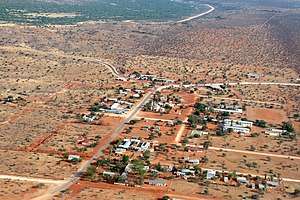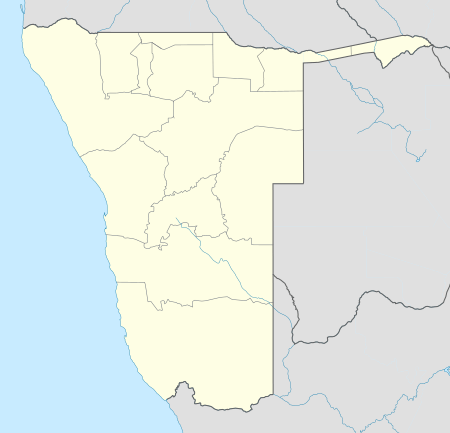Leonardville, Namibia
Leonardville is a village in Omaheke Region in eastern Namibia. It belongs to the Aminuis electoral constituency.[1] The place normally receives an annual average rainfall of 236 millimetres (9.3 in), although in the 2010/2011 rainy season 530 millimetres (21 in) were measured.[2]
Leonardville Naosanabis Wesley Vale | |
|---|---|
Village | |
 Bird's eye view of Leonardville (Picture from October 2015) | |
 Leonardville Location in Namibia | |
| Coordinates: 23°30′S 18°48′E | |
| Country | |
| Region | Omaheke Region |
| Constituency | Aminuis Constituency |
| Time zone | UTC+2 (SAST) |
| Climate | BWh |
Leonardville was the main settlement of the Khaiǁkhaun (Khauas Nama) subtribe of the Oorlam people until their military defeat against Imperial Germany's Schutztruppe soldiers in 1894 and 1896.[3]
History
The area around Leonardville was inhabited by the Taa-speaking subtribe of the San people until the Khaiǁkhaun (Red Nation), who called the place Naosanabis, occupied their land.[4] Around 1840 the group around Amraal Lambert, first Kaptein of the Kaiǀkhauan Orlam, moved into the area. They had been granted residence and pasture in the land of the Red Nation against an annual fee.[5] In 1843 the Wesleyan Missionary Society established a missionary station here; its first missionaries were Joseph Tindall and his son Henry.[6] They named the settlement Wesley Vale. In 1855 the Rhenish Missionary Society took over the operations. They bought the existing buildings—the church, the pastor's house, and the forge—and began to run a school for 60 to 80 children.[7] Amraal Lambert's group, however, searched for a different place to settle. They moved to Gobabis in 1855[8] or 1856.[7]
Amraal Lambert and most of his family died from smallpox in 1864. Some time after that the Kaiǀkhauan, now under the leadership of Amraal's grandson Andreas, moved back to Naosanabis. From here they controlled important trade routes. Using their technological advantage of commanding firearms and horses they were waylaying and robbing merchants. In the 1880s the Kaiǀkhauan were considered a powerful and dangerous force.[3]
When Imperial Germany colonised the area a decade later, Lambert refused to sign a "protection treaty". Regarding the Kaiǀkhauan as a comparatively weak force by the Germans, their commander Theodor Leutwein mounted a surprise attack on Naosanabis on 6 March 1894 in order to set an example for the stronger forces in then German South-West Africa not to stand in his way.[8]
The Schutztruppe forces won the battle and expelled the village's residents. The land was given to Angola Boers,[3] farmers who participated in the Dorsland Trek migration movement from South Africa to Angola but decided to turn around and settle in South-West Africa.[9] After the Herero and Namaqua Genocide 1904/05, Isaak Witbooi of the ǀKhowesin (Witbooi Orlam) moved to Naosanabis—the Kaiǀkhauan clan had at that time ceased to exist due to the devastating attack by the Germans.[3] During South African administration the settlement was renamed to Leonardville after Dutch Reformed Church Minister Leonard.[10]
Dutch Reformed Church
The Dutch Reformed Church Leonardville (formerly known as NGK Leonard) was founded on the eleventh day of the eleventh month of 1944 (November 11) as the eleventh church of the Dutch Reformed Church in South Africa (NGK) in what was then South West Africa. Members named it after one of the church's local pioneers, the Rev. (and later Dr.) E.J. Leonard, who ministered across the vast plains on donkey carts and even reached some isolated farms on foot. Founded by around 500 members of the Dutch Reformed Church Gibeon, the congregation grew to a thousand within eight years. By 2010, rural depopulation had reduced the number to a mere 176.
The congregation occupied an area of 25,000 square kilometres (9,700 sq mi) at its foundation, as large as Rwanda. The resulting sprawl was alleviated somewhat by the secession of the Dutch Reformed Church Aroab in 1955. There was originally no congregational seat, so by 1952 it effectively consisted of four different wards, namely Uhlenhorst (140 members), Blumfelde (about 140 members), Aroab (about 360 members), and Pretorius (about 320 members). The parsonage was in Pretorius, and each ward had its own church hall where services were held once a month and communion offered twice a year.
People
Despite the encroachment of Tswana, Orlams, and Boers, there is still a considerable San population. Of the estimated 500 remaining Taa speakers in Namibia, over 50 reside in Leonardville.[4]
Politics
Leonardville is governed by a village council that has five seats.[11]
In the 2010 local election in the village, the ruling SWAPO party won three of the five seats on the village's local council. The Rally for Democracy and Progress (RDP) and the National Unity Democratic Organisation (NUDO) each won a single seat.[12] The 2015 local authority election ended with the same result, three seats for SWAPO, and one each for NUDO and RDP.[13]
Notable residents
Jan de Wet, Namibian farmer and former politician, settled in Leonardville.[14]
References
- Mauku, Iuze (23 November 2010). "Presidential Affairs Minister visits Leonardville". Namibian Broadcasting Corporation (NBC). Archived from the original on 20 July 2011. Retrieved 5 February 2011.
- Menges, Werner (26 May 2011). "Rainy season was one for the record books". The Namibian. Archived from the original on 15 December 2011.
- Shiremo, Shampapi (14 January 2011). "Captain Andreas Lambert: A brave warrior and a martyr of the Namibian anti-colonial resistance". New Era. Archived from the original on 8 December 2012. Retrieved 2 February 2011.
- "Taa". Dokumentation bedrohter Sprachen (Documentation of Endangered Languages). Retrieved 5 February 2011.
- Vedder 1997, p. 177.
- Dierks, Klaus. "Chronology of Namibian History, 1843". Retrieved 5 February 2011.
- Vedder 1997, p. 325.
- Dierks, Klaus. "Biographies of Namibian Personalities, L". Retrieved 14 January 2011.
- "The Dorsland Trekkers". tourbrief.com. Retrieved 25 June 2010.
- Dierks, Klaus. "Biographies of Namibian Personalities, W". Retrieved 5 February 2011.
- "Know Your Local Authority". Election Watch (3). Institute for Public Policy Research. 2015. p. 4.
- SWAPO wins 3 seats in Leonardville Local Authority Namibian Broadcasting Corporation, 29 November 2010
- "Local elections results". Electoral Commission of Namibia. 28 November 2015. p. 5. Archived from the original on 10 December 2015.
- Jan de Wet Archived 2009-03-13 at the Wayback Machine at Who's Who in Southern Africa
Literature
- Olivier, P.L. (1952). Ons gemeentelike feesalbum [Our congregational holiday album] (in Afrikaans). Cape Town and Pretoria: Dutch Reformed Church Press.CS1 maint: ref=harv (link)
- Vedder, Heinrich (1997). Das alte Südwestafrika. Südwestafrikas Geschichte bis zum Tode Mahareros 1890 [The old South-West Africa. South-West Africa's history until Maharero's death 1890] (in German) (7th ed.). Windhoek: Namibia Scientific Society. ISBN 0-949995-33-9.CS1 maint: ref=harv (link)